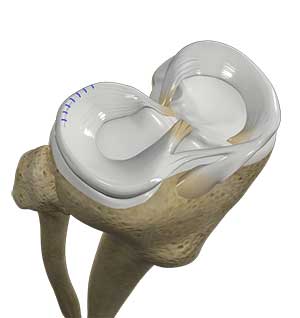Meniscus Function
The meniscus is an important shock absorber in the knee joint made of fibrocartilage Due to the high mechanical loads on the joint it can get injured as a result of an acute knee injury or chronic overload from repetitive impact or deep bending activities. The meniscus is an important structure for load transmission and shock absorption in the knee. The knee is subjected to 5-10 times body weight during impact activity, and half this force is transmitted through the meniscus with the knee straight, and 85% of the force goes through the meniscus with the knee bent ninety degrees. Loss of the meniscus increases the pressure on the articular (gliding) cartilage, which leads to degenerative changes. In addition, torn meniscus generally produces pain in the region of the tear and swelling in the knee joint. These symptoms are made worse with pivoting motions, squatting, and vigorous activities. Torn meniscus fragments can get caught in the knee joint and cause catching sensations. If a large enough fragment becomes lodged between the bearing surfaces, the knee may ‘lock’ and become unable to be fully bent or extended. Meniscus tears can be treated by meniscus removal (meniscectomy), meniscus repair, or in unusual circumstances, meniscus substitution or transplantation.
Meniscal Repair and Preservation
Meniscectomy, removal of the damaged meniscus tissue, has good short term results but can lead to the development of arthritis ten to twenty years later. The primary goal of meniscus preservation is to save and heal the torn meniscus tissue and to preserve its important shock absorber function for the joint which is particularly important for active individuals. A meniscus tear requires a blood supply to heal. Only the outer third portion of the meniscus has blood supply to enable healing of a tear. Repairs are generally limited to this peripheral region of the meniscus. Many types of meniscus tears occur in the region of the meniscus without adequate blood supply for healing. Meniscus removal has been traditionally been recommended for tears to regions of the meniscus without blood supply but innovative surgical instrumentation and novel regenerative biotechnology has allowed for extension of the traditional indications for meniscal repair.

Arthroscopic meniscus repair is an outpatient surgical procedure to repair torn knee cartilage. The torn meniscus can be repaired by a variety of minimally invasive techniques depending on tear location and type, and requires postoperative protection to allow healing. Physical therapy is useful to regain full function of the knee, which occurs on average 3-5 months after the surgery.
Since the goal of surgery is to preserve healthy meniscus, meniscus repair is attempted when the tear is repairable. Meniscus repair has good results, but has a longer recovery time than meniscectomy and is limited to certain tear patterns which are amenable to repair. While meniscus repair is typically recommended for younger patients since the blood supply changes in the meniscus with age, a newly recognized tear pattern of the so called “meniscal root” can be repaired successfully even at later age with positive effects for joint preservation.
When performed by an experienced surgeon, meniscus repair is a highly successful procedure, with good results in up to 90% of patients. Any knee that is injured has a higher likelihood of developing arthritis. A successful repair slows the development of arthritic changes. Factors associated with higher rates of meniscus healing include repair within 2 months, more peripheral tear location, and concomitant ACL reconstruction.
Even though the recovery is longer for a meniscus repair than for a meniscectomy, any repairable meniscus should generally be repaired. Meniscus repair is considered when:
- Patient is healthy and wishes to remain active
- Patient understands the rehabilitation, and accepts the risks of surgery
- Meniscus tear is located in the periphery of the meniscus
- Patients with meniscal root tears
- Meniscus tissue is of good quality
- Surgeon is experienced in meniscus repair










